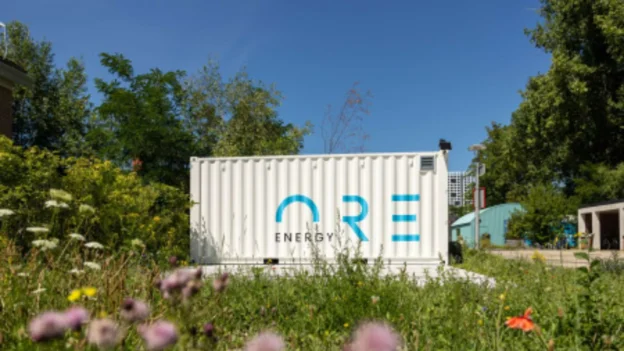Ore Energy has connected the world’s first fully operational iron-air battery system to the Dutch grid in Delft, securing $23 million in European funding as the global iron-air battery market projects growth from $3.78 billion in 2023 to $10.14 billion by 2031. This achievement positions the Netherlands-based startup as Europe’s primary challenger to Form Energy, which has raised over $1.2 billion and announced a $760 million manufacturing facility while targeting $20 per kWh costs that undercut lithium-ion batteries by 90%.
Founded in 2023 as a TU Delft spin-out, Ore Energy’s system provides multi-day energy storage using only iron, water, and air, yet the company faces substantial scaling challenges to compete with Form Energy’s established market position and proven fundraising capabilities. The European focus on supply chain independence may provide regulatory advantages, though technical performance and cost competitiveness remain unverified at commercial scale.
Market Positioning and Competitive Landscape
Form Energy has demonstrated iron-air batteries at one-tenth the cost of lithium-ion systems, largely due to cheap and abundant primary materials, establishing performance benchmarks that Ore Energy must match to achieve market viability. Form’s technology targets 100-hour storage duration at costs competitive with legacy power plants, creating direct competition for applications requiring multi-day storage capabilities.
Form Energy’s $760 million manufacturing facility investment demonstrates significant confidence in iron-air battery viability, contrasting with Ore Energy’s $23 million funding level that limits near-term scaling opportunities. The funding disparity suggests different strategic approaches: Form Energy prioritizes rapid commercial deployment while Ore Energy focuses on European market development with government support.
Form Energy aims for commercial production in late 2024 with battery packs under $20 per kWh, establishing cost targets that could make iron-air technology price-competitive with fossil fuel generation for long-duration applications. Ore Energy has not disclosed specific cost targets, creating uncertainty about competitive positioning against both Form Energy and existing storage technologies.
Technology Validation and Operational Challenges
The Delft installation at TU Delft’s Green Village test campus provides real-world validation of iron-air technology under European grid conditions, though the system’s size and operational parameters remain undisclosed. The system delivers up to 100 hours of storage for multi-day energy shifting to support renewable integration, matching Form Energy’s duration claims while demonstrating European technical capabilities.
Ore Energy’s battery uses iron and water through reversible oxidation processes that convert rust back to iron form when charged with electricity, indicating similar technical approaches to Form Energy but potentially different implementation strategies. The lack of detailed performance data from the Delft installation limits assessment of efficiency, capacity utilization, and operational reliability compared to laboratory conditions.
The modular 40-foot container design suggests standardized deployment approaches that could facilitate scaling, though manufacturing capacity and supply chain development remain unaddressed. Container-based systems require significant infrastructure integration for grid-scale deployments that extends beyond individual unit performance to system-level coordination and maintenance.
European Supply Chain Strategy and Policy Alignment
Ore Energy’s emphasis on exclusively European-origin materials aligns with EU strategic autonomy objectives for critical technologies, potentially providing regulatory advantages for European market penetration. This positioning contrasts with Form Energy’s US-focused manufacturing strategy and may create opportunities for policy-supported deployment in European markets prioritizing supply chain independence.
The company has secured subsidies and grants largely from European government entities, bringing total funding to approximately $23 million, indicating policy support for domestic technology development. However, government funding often comes with deployment requirements and performance milestones that may constrain strategic flexibility compared to private capital.
The European focus may limit global market opportunities where cost competitiveness becomes the primary selection criterion. Form Energy’s broader market approach and substantial private funding provide advantages for international expansion that government-supported European companies may struggle to match without policy intervention.
Scaling Timeline and Commercial Viability
Ore Energy’s plan to reach GWh-scale production by 2030 requires substantial capacity expansion from the current Delft installation, creating execution risks that could affect competitive positioning. Company projections indicate grid connections in 2025 and large-scale production by 2027, timelines that may prove optimistic given typical industrial scaling challenges and supply chain development requirements.
The seven-year timeline from foundation to GWh production compresses typical technology development cycles and may require continuous funding support that exceeds current European policy commitments. Manufacturing scale-up typically requires iterative design optimization and quality control development that could extend projected timelines and increase capital requirements.
The global iron-air battery market’s 13.20% CAGR projection through 2031 suggests substantial growth opportunities, yet market development depends on successful technology validation and cost reduction that remain unproven for most participants. Ore Energy’s European market focus may provide protected development opportunities, though global competitiveness will ultimately determine long-term viability against established players like Form Energy with superior financial resources and technical validation.
